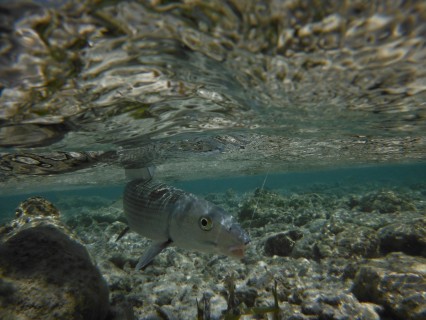Bonefishing at Turneffe Flats: Just Like Marketing!
This post is for fun, but as I write it I can’t help but see parallels between fishing for “bones” and inbound marketing. The equipment, tactics, strategies and execution needed to catch a bonefish are similar to those required for effective marketing.

I just returned from a great trip to Belize and Turneffe Flats – a premier and beautiful destination to fish for bonefish, permit and tarpon as well as go diving or eco-touring.
I am very much an amateur at bonefishing and this was my second attempt. This time, I was able to work a bit on techniques like the “double haul” – thanks to my guide, Michael, and lessons from Jad! I was also able to target specific fish (instead of just casting to a school of fish) as well as “hunting” and casting for permit for the first time. I think I caught about 20-25 bonefish over the course of the week. Nothing compared with the real pros that visit the flats.
The connections to marketing are clear when you think about some of the bonefishing activities:
- Equipment = Revenue Systems
- Spotting = Market Targeting
- Fly Selection = Content
- Casting = Creative Programs
- Placement = Placement
- Stripping = Drip Campaigns
- Playing = Nurturing
- Landing = Closing
I will explore each of these – focusing on fishing – but if you read along, I suspect you will see some analogies to revenue marketing!!
Equipment: Bonefishing in windy conditions requires a larger rod than small stream flyfishing. A 9’ rod is about right and technology has changed rapidly over the last few years. A large arbor reel is critical, as the bonefish tend to run hard and fast requiring a rapid return using the reel. The line must be weighted well for the conditions and appropriate for a salt water environment.
Spotting: Spotting fish is half the fun. Bonefish will move in schools in the flats and can be spotted quite easily. Of course they can also spook easily as well so placing the fly is critical. In deeper water, they are harder to see, but a trained eye can spot the fish as a moving “dark spot” along a sandy bottom or in a pool.
Fly Selection: Bonefish seem to eat mostly small shrimp or crabs. Specialists can craft particularly attractive flies and know when to change things up when the fish look but don’t take the fly.
Casting: With all right the equipment in place and the right fly on the line, it is time to start fishing. Fly casting is an art, and depending on conditions like wind, the casting techniques are critical. Better fisherman work a double haul to add power to the cast and drive the line further and straighter. Delicate landing and distance are also key factors in an effective cast.
Placement: Where do you place the fly? Placement varies by fishing type. For bonefish, it is critical to place the fly in a position that is consistent with the natural activities of the bait. Bonefish flies sink and can be placed in front of the moving fish.
Stripping: After you place the fly, you can begin the retrieve. Clearly a shrimp moves differently then a crab, and the strip will vary by the type of water and the movement of the fish.
Playing: With a fish on the line, it is time to play it. The first move is to set the hook with a firm strip and then it is critical to keep a “tight line” perhaps using your palm on the reel or the reel’s drag. Fish can run and with the right level of resistance, should not snap the line. A loose line that could easily snag should be avoided. As the fish is idle or moving toward you, reel in quickly using the large arbor reel.
Landing: A fish in hand is a caught fish and as with many sport fist, the policy is to catch and release. As a result, you will want to treat the fish delicately while removing the hook. Watch out for barracuda who love to attack vulnerable fish that are either on the line or being let go.
Happy fishing at Turneffe Flats and ‘tight lines’!
If you want to learn more about how fishing is like marketing, contact me!


Thanks, Jad! Yes indeed we will work on getting back!
Awesome John! Great connection! Hope to see (and fish) with you again!